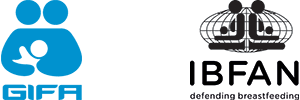
GIFA supports Nanette Jolly’s demand that the the exclusively breastfed child (0-6months) should be the baseline, i.e. the controll group, and to consider anything that deviates from this practice, as « study group ».
Instead of showing that breastfed children « do better » or have « less risk of» obesity, diabetes, cancer asf., research would show that children who are not breastfed have odds and risks. We therefore would like to share Nanette Jolly’s article on this topic. In her abstract, she writes:
“Most comparative infant feeding research uses formula, not breastfeeding, as the control. This approach violates the rules of scientific research, misrepresents the findings, and blunts both professional and public response to the higher morbidity and mortality risks of formula feeding.
A clinical scientific study evaluates a potentially useful therapeutic intervention against normal physiological healthy function, which is the control. The intervention is found to be useful when it restores normal function as closely and safely as possible. A scientist who gave this any thought would not allow the artificial substitute for normal physiology to be treated as the control to evaluate the “benefits” of breastfeeding. We never compare eating with intravenous nutrition and conclude that eating is best, because it has advantages over a nasogastric tube or intravenous parenteral nutrition, and fewer complications.
Unscientific presentation of research findings is misleading. And the consequences of unscientific misleading reporting of research findings are significant. When breastfeeding is treated as the control, the evidence is that substitutes are inferior and carry significantly higher risks of morbidity and mortality than the physiological normal,1 with exceptions only in a few pathological conditions. The risks are misrepresented by using the wrong control—the risk of SIDS is not halved by breastfeeding; it is doubled by formula feeding.2,3
“Language has power. ….it impacts thought and behaviour.”4 Researchers abuse that power when they report overwhelmingly that breastfeeding is the superior infant feed. Outcomes of infant feeding studies almost always conclude that breastfeeding is best, has benefits and advantages, and lowers risks of morbidity and mortality when compared with alternative feeds.5 In reality, those alternative feeding practices are associated with increased morbidity and mortality. And this misrepresentation results in only a small minority realizing this.
Most authoritative guidelines and abstracts reporting infant feeding research begin with the statement that breastfeeding is the ideal/best nutrition for babies.6,7 This idealization of breastfeeding implies that it is unlikely to be attainable for normal mothers. Formula, erroneously used as the control in research findings, is seen as normal, and so “good enough.”
Assuming that using formula is normal, and reporting that breastfeeding has advantages and benefits, which are an optional choice (and thus do not matter much) deprives mothers of information they need before making important decisions affecting their, and their babies’, short- and long-term health.
Professional journal articles are the major source of physician knowledge, both informing their training and keeping them updated. And they determine physicians’ management of breastfeeding, whether for individuals or in the development of guidelines and protocols. Health care providers are an authoritative and influential part of the culture. Thus the unscientific presentation of research has consequences for the entire culture.8
We must take responsibility for our part in reinforcing an artificial feeding culture and take the lead in changing it to a breastfeeding culture.9
It is time for journals to commit to science, and breastfeeding journals have an ethical responsibility to lead. Misrepresenting outcomes in research is scientific misconduct.10
We must publish infant feeding research that uses breastfeeding as the physiological normal, the control in any research, against which the medical/artificial intervention, usually formula, is identified and evaluated11 with doses and durations of the substitute given, quantifying risks accordingly. The research findings will not change, only their presentation.
We promised to first do no harm when we qualified. This includes the ethical obligation to publish the presentation of research findings scientifically. Failure to follow the science will continue to cause significant damage to the present and future health of mothers and babies by misleading professionals, and thus the culture.” End of Quote
If generally applied, this approach of scientifc studies would considerably change the public’s view on breastfeeding which is not a feeding practice among others, but basic investement in baby and mother’s health, on the long term.
Source: https://doi.org/10.1089/bfm.2022.0123
References:
1. World Alliance of Breastfeeding Associations. Dangers of Formula. Available at http://waba.org.my/v3/wp-content/uploads/2018/08/21-dangers-of-infant-formula-danger-2012.pdf (accessed May 2, 2022). Google Scholar
2. Landa-Rivera JL, Perez-Perez J, Gonzalez-Nunez MDP, et al. Population-based survey showing that breastfed babies have a lower frequency of risk factors for sudden infant death syndrome than nonbreastfed babies. Breastfeed Med 2022;17:182–188. Link, Google Scholar
3. Vennemann M, Bajanowski T, Brinkmann B, et al. GeSID Study Group. Does breastfeeding reduce the risk of sudden infant death syndrome? Pediatrics 2009;123:e406–e410. Crossref, Medline, Google Scholar
4. Bartick M, Stehel EK, Calhoun SL, et al.; The Academy of Breastfeeding Medicine. Academy of breastfeeding medicine position statement and guideline: Infant feeding and lactation-related language and gender. Breastfeed Med 2021;16:587–590. Link, Google Scholar
5. Ware JL, Chen A, Morrow AL, et al. Associations between breastfeeding initiation and infant mortality in an urban population. Breastfeed Med 2019;14:465–474. Link, Google Scholar
6. Center for Disease Control and Prevention. About Breastfeeding. Available at www.cdc.gov/breastfeeding/about-breastfeeding/index.html (accessed May 2, 2022). Google Scholar
7. Ozmen EB, Okman E, Nur Sari F, et al. Comparison of the macronutrient content of colostrum: Locals with refugees. Breastfeed Med 2020;15:453–457. Link, Google Scholar
8. Akre J. The Problem with Breastfeeding: A Personal Reflection, Part 1. Amarillo, TX: Hale Publishing, 2012, p. 11. Google Scholar
9. Wiessinger D. Watch your step. Jnl Human Lactation 2021;37:484–488. Google Scholar
10. Mary-Ann Liebert, Publisher , Breastfeeding Medicine. Manuscript submission guidelines and policies. Available at https://home.liebertpub.com/authors/writing-guidelines/151 Post publication policies>Misconduct (accessed May 31, 2022). Google Scholar
11. Smith JP, Dunstone MD, Elliott-Rudder ME. “Voldemort and Health Professional Knowledge of Breastfeeding—Do Journal Titles and Abstracts Accurately Convey Findings on Differential Health Outcomes for Formula Fed Infants?” Canberra, Australia: Australian Centre for Economic Research on Health, 2008. Google Scholar
Photocredit: https://abcnews.go.com/Health/studies-show-moms-benefit-breastfeeding/story?id=35398924
